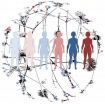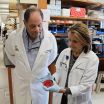(Press-News.org) DALLAS, March 19, 2014 — A new kind of single-dose vaccine that comes in a nasal spray and doesn't require refrigeration could dramatically alter the public health landscape — get more people vaccinated around the world and address the looming threats of emerging and re-emerging diseases. Researchers presented the latest design and testing of these "nanovaccines" at the 247th National Meeting & Exposition of the American Chemical Society (ACS), the world's largest scientific society.
Their talk was one of more than 10,000 presentations at the meeting, being held here through Thursday at the Dallas Convention Center and area hotels.
"Our nanovaccine approach could be instrumental for containing future outbreaks of recently emerged and re-emerging diseases, such as SARS, new flu strains and multi-drug resistant tuberculosis," said Balaji Narasimhan, Ph.D., the project's lead researcher.
He noted that most of today's vaccines require needles, boosters and refrigeration, all of which pose challenges for doctors and patients. Other than the pain factor, which can lower the chances that someone will seek out a vaccine, follow-up shots and refrigeration further reduce the reach of these vitally important preventive treatments. In some places with limited resources, refrigeration simply isn't available. Thus, many people who need vaccinations the most aren't getting them at all. The good news is that the vaccines Narasimhan's team is developing don't need to be kept cold and are easy to administer.
"Our nanovaccines can be stored at room temperature for as long as six to 10 months and still work," said Narasimhan, professor of chemical engineering at Iowa State University. "Also, we're designing them so they get delivered in one dose through a nasal spray, which could potentially allow patients to give the vaccine to themselves."
Another major limitation of traditional vaccines is the way they work, he said. Most current vaccines help a person develop disease immunity by introducing part of a virus or bacteria and triggering the body's humoral response — the part of the immune system that produces antibodies to fight off a harmful pathogen. Later, if the person gets infected by that microbe, the body immediately knows how to respond.
But increasingly, evidence is emerging that the other component of the body's immune system, what's called the cell-mediated arm, also plays an important part in some emerging and re-emerging diseases, such as whooping cough. This side of the immune system depends on a group of cells called T cells, rather than antibodies, to fight viruses and bacteria.
Part of the elegance of these nanovaccines is their simplicity and versatility, Narasimhan explained. They are made of only two components: bits of proteins from a virus or bacteria packed into nontoxic, biodegradable polymers that can be custom-designed.
When administered through the nose or by a shot, these tiny packages enter the body and flag the immune system. Sentinels called antigen-presenting cells that keep watch in the body for foreign invaders gobble up the nanovaccine particles, chop up the polymers and pathogen proteins, and appropriately put pieces of the proteins on their surfaces. Depending on the chemistry of the nanovaccine, this triggers the body's cell-mediated or humoral immune response and trains it to recognize the pathogen and attack it quickly in case of future infections.
"We have exciting results that attest to the ability of the nanovaccine formulations to do a very good job of activating cell-mediated immunity," said Narasimhan. "We've shown that it works with rodents, and we're moving forward to show that in larger animals, as well."
INFORMATION:
A press conference on this topic will be held Wednesday, March 19, at 8:30 a.m. Central time in Room A122/A123 of the Dallas Convention Center. Reporters can attend in person or access live video of the event and ask questions at the ACS Ustream channel http://www.ustream.tv/channel/acslive.
Funding for this work came from the National Institute of Allergy and Infectious Diseases, the United States Army Medical Research and Materiel Command and the Department of Defense Office of Naval Research.
The American Chemical Society is a nonprofit organization chartered by the U.S. Congress. With more than 161,000 members, ACS is the world's largest scientific society and a global leader in providing access to chemistry-related research through its multiple databases, peer-reviewed journals and scientific conferences. Its main offices are in Washington, D.C., and Columbus, Ohio.
To automatically receive news releases from the American Chemical Society, contact newsroom@acs.org.
Note to journalists: Please report that this research was presented at a meeting of the American Chemical Society.
Follow us: Twitter | Facebook
Title
Pathogen mimicking nanovaccine platform technology: A new paradigm
Abstract
The design of vaccines and therapeutics to address infectious diseases is fraught with challenges ranging from the need for cold storage to poor immunogenicity to the need for multiple doses to the need for needle-based methods that require medical professionals to administer. We have developed a cross-disciplinary approach at the intersection of polymer chemistry, nanotechnology, and immunology for the molecular design of a safe, needle-free, and efficacious nanoparticle-based platform that can address these challenges and provide a robust technology to address both pre- and post-exposure to respiratory pathogens. These biodegradable nanoparticles are based on amphiphilic polyanhydrides, which degrade by hydrolytic cleavage of the anhydride bond. We have shown using a bottom-up approach that vaccine adjuvants based on amphiphilic polyanhydride nanoparticles are capable of mimicking a natural infection and inducing a robust immune response with long-lived protection against a subsequent challenge. The nanoparticles possess the unique ability to mimic pathogens with respect to persisting within and activating immune cells as well as rapidly distributing to tissue sites distal to the site of administration. Furthermore, these particles can be targeted for uptake by immune cells by functionalizing their surface with carbohydrates, enabling more efficient delivery of antigen to dendritic cells and macrophages.
Our studies have shown that the nanoparticles are safe when administered via multiple routes – intranasal, subcutaneous, and intramuscular. These particles are stable at high temperature for extended periods of time obviating the "cold chain", which is a major hurdle in the deployment of vaccines to remote regions of the globe. The nanoparticles can be designed to encapsulate fragile protein antigens and deliver them in a sustained manner to immune cells, facilitating the maintenance of antigen-specific CD8+ and CD4+ T cells. We have demonstrated that these nanovaccines confer full protection in a single intranasal dose ten months prior to lethal challenge by several respiratory pathogens. Additionally, these particles can be used for effective intracellular delivery of antibiotics in a single administration, which results in lower toxicity, enhanced patient compliance, dose sparing, and cost savings. This rational approach for designing novel amphiphilic materials as nanoscale adjuvants and therapeutics has the tantalizing potential to catalyze the development of next generation technologies against emerging and re-emerging diseases.
No-refrigeration, spray vaccine could curb diseases in remote areas
2014-03-19
ELSE PRESS RELEASES FROM THIS DATE:
Understanding binge eating and obesity
2014-03-19
VIDEO:
In this JoVE video article, a set of methods to measure food-related motivation and values are described in JoVE's peer-reviewed video article format.
Click here for more information.
March 19, 2014 —Researchers at the University of Cambridge have developed a novel method for evaluating the treatment of obesity-related food behavior. In an effort to further scientific understanding of the underlying problem, they have published the first peer-reviewed video of their technique ...
101 liver cancer drug candidates pave the way to personalized medicine
2014-03-19
The heart disease drug perhexiline is one of 101 compounds predicted to prevent cancer growth in most patients suffering from our most common liver cancer, HCC. This is an outcome from a novel simulation-based approach using personal sets of proteins of six HCC patients.
"This is the first time personalized models have been used to find and evaluate new potential drugs," says Professor Jens Nielsen at Chalmers University of Technology.
--
Our most common liver cancer, Hepatocellular carcinoma, HCC, causes more than half a million deaths worldwide every year. If the ...
Gut bacteria can cause life-threatening infections in preterm babies
2014-03-19
Babies born prematurely are surviving in increasing numbers. But many withstand complications of early birth only to suffer late-onset sepsis — life-threatening bloodstream infections that strike after infants reach 72 hours of age.
While early-onset sepsis often is caused by pathogens acquired from the amniotic sac or birth canal, the causes of late-onset sepsis have been far less clear.
But now, researchers at Washington University School of Medicine in St. Louis have discovered that preterm babies' guts harbor infectious microbes that can cause late-onset sepsis.
The ...
Drinking alcohol several times a week increases the risk of stroke mortality
2014-03-19
Consuming alcohol more frequently than twice a week increases the risk of stroke mortality in men, according to a study carried out at the University of Eastern Finland. The results show that the effects of alcohol are not limited to the amount consumed, but also the frequency of drinking matters. The results were published in Acta Neurologica Scandinavica on 8 March.
Excessive consumption of alcohol is associated with a variety of different diseases. The relationship between alcohol consumption and ischaemic stroke shows a J curve pattern, which means that in people ...
GPS also helps to analyze global water resources
2014-03-19
This news release is available in German. FRANKFURT. WaterGAP (Water Global Assessment and Prognosis) is a hydrological model used to model water shortage, groundwater depletion, and floods and droughts (e.g. as impacted by climate change) over the land area of the globe. The Frankfurt hydrologist Prof. Petra Döll has examined how good a fit this model provides, using GPS observations and data from the GRACE satellite, which measures the gravitational field of the Earth. The study, published in the current issue of the scientific journal Surveys in Geophysics indicates ...
Rewrite the textbooks on water's surface tension
2014-03-19
Researchers from the University of Melbourne and University of Sydney are confident their new reaserach results will make significant differences to the calculations of surface tension of water used by the next generation of atmospheric scientists, biophysicists and engineers of technology like inkjet printers.
These latest investigations have clinched a long-standing controversy amongst the physical Chemistry community; the air-water interface is negatively charged by the adsorption of hydroxide ions.
Prof Angus Gray-Weale from the Chemistry, Department of Chemistry ...
Ottawa researchers find new pathway connected to type 2 diabetes
2014-03-19
Ottawa, ON, March 19, 2014 — Scientists at the Children's Hospital of Eastern Ontario (CHEO) Research Institute have discovered a cellular pathway that is responsible for keeping blood sugar levels low in obese or pre-diabetic people, and may prevent the onset of Type 2 diabetes. The discovery published this month in a leading journal Nature Cell Biology.
Following a meal, beta cells found in islets of the pancreas secrete insulin that helps to store food energy for future use. The inability of islet beta cells to produce enough insulin leads to diabetes. Unlike other ...
Postoperative cognitive dysfunction
2014-03-19
Older persons, in particular, tend to suffer from memory lapses and other types of cognitive impairment after undergoing surgical procedures (postoperative cognitive dysfunction, POCD). Surgery has been performed on older patients much more commonly in recent years than ever before, and their pre- and postoperative care has become an important matter. Ingrid Rundshagen, an anesthesiologist, has surveyed the available literature to find out what kinds of patients are more likely to have cognitive impairment after surgery, and how the clinical manifestations should best be ...
Diversity in UK gardens aiding fight to save threatened bumblebees, study suggests
2014-03-19
The global diversity of plants being cultivated by Britain's gardeners is playing a key role in the fight to save the nation's threatened bumblebees, new research has revealed.
Ecologists at Plymouth University, in a study published this week, have shown the most common species of bumblebee are not fussy about a plant's origin when searching for nectar and pollen among the nation's urban gardens.
But other species – and, in particular, long-tongued bees – do concentrate their feeding upon plants from the UK and Europe, for which they have developed a preference evolved ...
EU could afford to lead international climate action
2014-03-19
Major emitting countries may have to join the EU's effort much earlier to avoid a temporary overshoot of the 2 degree target, but even if they joined only in 2030, the overshoot would be limited to roughly 0.2 to 0.4 degrees Celsius. The initial unilateral leadership could be achieved at little extra costs for the EU. Late-comers would have the benefit of lower costs while they delay action but would face higher transient costs once their turn to decarbonize comes.
"The crisis-stricken EU is asking itself whether it can still afford climate leadership" says lead-author ...



